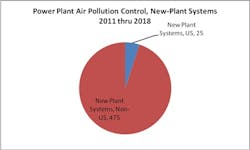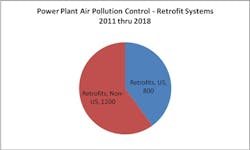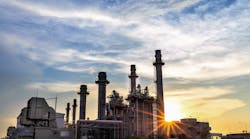Electrostatic Precipitators: A number of older precipitators will be upgraded to improve performance. New plants in Asia will mostly be equipped with electrostatic precipitators.
Fabric Filters: Fabric filters are needed to meet the new toxic rules in the United States. New coal-fired boilers in the U.S. and a few other countries will be equipped with fabric filters. Some projects include two fabric filters. The first filter collects the flyash. The second filter is used with chemical injection and collects mercury and sulfates.
Scrubbers: Wet limestone scrubbers are being installed in many plants around the world. Dry and semi-dry scrubbers utilizing lime will be a sizable minority of the installations. Niche choices include scrubbing with seawater and ammonia. Some plants located near sulfuric acid purchasers are choosing to make this acid.
Chemical Injection Systems: A variety of chemical injection systems are being installed. Injection of lime will be used to boost hydrogen chloride and SO2 capture in various plants throughout the world. Activated carbon will be injected primarily in the United States for mercury removal. Halogens, including bromine and chlorine, will also be injected in the United States for mercury removal.
DeNOx Systems: Chinese power plants located in the major urban zones are being required to install selective catalytic reduction systems (SCR). The United States power plants will also install an additional 300 SCR systems to supplement those installed to meet a 2010 deadline. Selective non-catalytic reduction (SNCR) will be used for some of the projects, but due to this technology”s lower reduction efficiency, it will be less popular.




